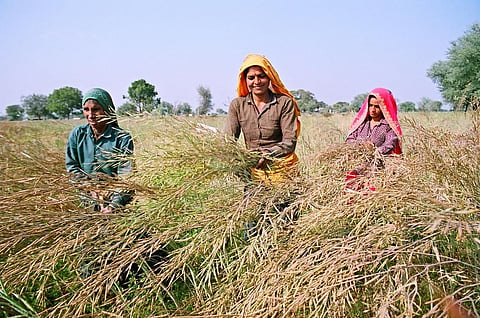Union Budget 2021-22: What should be the priorities for agriculture?
The agriculture sector has continued to serve as a lifeline at a time when the novel coronavirus disease (COVID-19) pandemic has hurt every economic activity in an unprecedented manner. It has not only ensured food supply but also provided livelihoods to daily-wage workers during the lockdown, providing the last resort for those rendered homeless.
The Union Budget 2021-2022 to be presented on February 1, should give special focus to the immediate as well as structural problems on the sector.
Addressing depressed demand
The prices of almost all crops and animal products crashed in the recent past due to distortions in the supply-chain as well as consumers’ inability to afford commodities, resulting in a decline in rural demand. So, providing more money to rural populations will lift up agriculture and allied sectors.
PM-Kisan, which provides Rs 6,000 annually to an agricultural household as income security, needs to be enhanced. Its coverage should widened by taking tenants, landless agricultural workers and female farmers, among others, into its ambit.
Likewise, the Mahatma Gandhi National Rural Employment Guarantee Act (MGNREGA) emerged as an employment option during the pandemic due to limited employment opportunities outside agriculture. Viewing the sudden surge in the demand for work under MGNREGA, in addition to budgetary allocation of Rs 61,500 crore for the year through March 31, 2021, a fund of Rs 40,000 crore was announced in a welcome step.
Increasing budgetary allocations towards MGNREGA is non-negotiable in the forthcoming Budget as well.
Focus on vulnerabilities
In rainfed or dryland regions, the livelihood of farmers remains vulnerable even in normal times. These farmers rely upon income from non-farm activities (40 cent of the total agricultural income) significantly.
A number of measures have also been announced previously as a part of Atma Nirbhar Bharat Abhiyan and previous year’s Budget for making the rainfed or dryland agricultural climate-resilient as well as allied activities profitable. Some of these include multi-tier cropping, capacity and quality of storage in the country at the block- or taluk-level, bee-keeping, solar pumps and zero-budget natural farming.
However, there has not been much progress on the ground as budgetary provisions in some of these programmes or schemes are either non-existent or inadequate to address the challenges of rainfed agriculture and allied activities.
The Budget 2021-22 should clearly project the provisions under such schemes.
Prioritising infrastructure
Apart from efforts aimed at helping the agrarian economy recover, the Union government should enhance expenditure on agricultural infrastructure. It gave higher importance to cash-based schemes, as compared to expenditure enhancing infrastructure base for the sector in previous Budgets.
The pandemic has hit agricultural operations hard. A number of reports have highlighted that farm operations suffered due to infrastructure bottlenecks such as supply chain distortions, non-availability of credit, lack of quality inputs and marketing infrastructure.
One of the major reasons pointed out was the lack of public infrastructure. So, it is high time to rethink the development strategy towards building the infrastructure supporting agriculture and allied sectors.
The increase in agriculture-sector expenditure in recent years has been on account of schemes like PM-KISAN, PMFBY, interest subvention schemes and price support scheme for farmers, with a focus on providing direct monetary benefits.
However, the public expenditure which enhances infrastructure and support agricultural activities is not picking up pace.
Allocations for Remunerative Approach for Agriculture and Allied sector Rejuvenation, National Food Security Mission and PM Krishi Sinchayee Yojana, schemes aiming at strengthening community-led agricultural infrastructure, which were prioritising agro-ecology based budgeting (like investments in rain-fed agriculture), are critical in enhancing the capacity of the agricultural production.
The share of such investments in the total Budget allocations towards agriculture has declined from 84 per cent in 2011-12 to 19 per cent in 2020-21. Hence, this Budget needs to ensure complementary provisioning of resources for agriculture and allied sectors that can address the root causes of the agrarian crisis in the country.
Last but not the least, food subsidy allocation was reduced to Rs 1.15 lakh crore in the last Budget from Rs 1.84 lakh crore in 2019-20. This, along with the announcements in favour of liberalising agricultural markets, introducing the three farm acts and providing marketing infrastructure through PPP models reveal that the government’s intention is to withdraw from procurement operations.
It is important to note that the introduction of welfare programmes like PM Garib Kalyan Anna Yojana during the pandemic was possible only because of availability of food grain stocks with the central authorities. Thus, provisioning for food security and strengthening public infrastructure for procurement is the need of the hour, especially when we are still far from the road to economic recovery.
This is the second in a series on the Union Budget 2021-2022 in collaboration with Centre for Budget and Governance Accountability.


